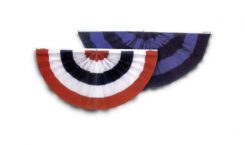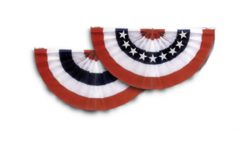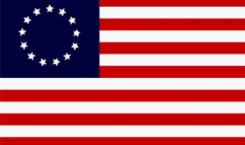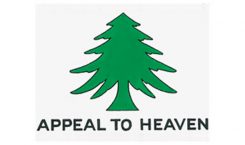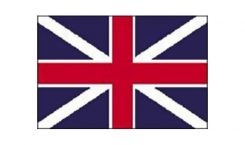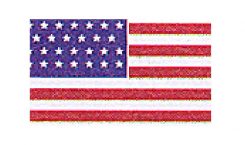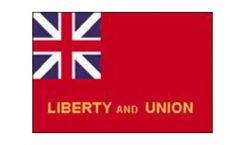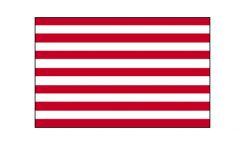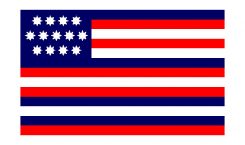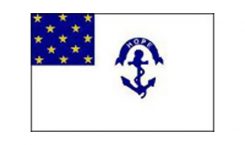No products in the cart.

Pulldowns, 50 Star
- Printed Stars
- Sewn Stripes
- Canvas Heading
- Brass grommets
Pleated Nylon Fans
Available in Red, White & Blue and Black & Purple
Pleated Cotton Fans
Available in Red, White & Blue and Red, White & Blue with Stars
Betsy Ross Flags
The “Betsy Ross Flag” is traditionally regarded as the first American flag. According to legend, in 1776 George Washington commissioned Betsy Ross to design a flag for the new continental army. The design she came up with featured thirteen alternating red and white stripes, with thirteen stars on a blue...
United States Historical Flag Washington’s Cruisers
All outdoor flags have a canvas heading with brass grommets.
This Revolutionary War ensign was hoisted by the six warships that General Washington fitted out in 1775. Since the General financed these vessels at his own expense, the fleet, and later its ensign, came to be known at Washington's Cruisers
United States Historical Flag Kings Colors
All outdoor flags have a canvas heading with brass grommets.
One of the military colors used by British colonial troops after 1743. As the BRITISH UNION FLAG it was the standard raised by the Jamestown settlers in 1607. The design originated when King James I of England combined the St.George Cross with the Scottish Cross of St Andrew.
United States Historical Flag Union Civil War- 34 Star
All outdoor flags have a canvas heading with brass grommets.
A star is added to the U.S. flag on the 4th of July following the admission of a State to the Union. (KS).
Star Spangled Banner – Fort McHenry Flag – 15 Star US Flag
The Star-Spangled Banner (aka, "The Fort McHenry Flag") features fifteen stars and fifteen stripes and is flown over Fort McHenry in Baltimore, Maryland, as it was in 1814 when Francis Scott Key composed the U.S. National Anthem.
The 15 star US flag was used from 1795 - 1818. The two stars that were added were for Kentucky and Vermont.
Taunton Historical Flag
This flag is another example of the colonists' modifying the British flag, in this case the British Red Ensign. The Taunton Flag was raised on the Liberty pole in Taunton, Massachusetts, on October 21, 1774.
United States Historical Sons of Liberty Flag
All outdoor flags have a canvas heading with brass grommets.
This was the flag of the early colonist who had joined together in the protest against the British impositions on American economic freedom.One such protest was resistance to the Stamp Act, on October 7, 1765. A delegate from each of the nine colonies formed the "Stamp Act Congress" . They
petitioned the king and parliament, the act was repealed on March 18,1766. The flag of nine red and white stripes that represented these "Sons of Liberty" became known as the "Rebellious Stripes." On December 16, 1773, the Sons of Liberty protested the parliament's Tea Act, an action that became known as the Boston Tea Party. The colonists' believed the tax to be a violation of their legitimate economic liberty. Three and a half years after the Tea Party the thirteen colonies had come together in their decision to fight for independence and the nine stripes had grown to thirteen. The Sons of Liberty would rally under a large tree which became known as "The
Liberty Tree
United States Historical Serapis Flag
All outdoor flags have a canvas heading with brass grommets.
This is the flag used on board the captured British ship "Serapis" in 1779, Captain John Paul Jones. This ship was captured following the famous sea battle between the "Serapis" and the "Bonhomme Richard" in which the latter's flag staff was blown away; the British Captain asked if Jones had struck his colors; and Jones replied "Struck, Sir? I have not yet begun to fight!" The "Bonhomme Richard" was so badly damaged that it sank with its colors flying. After putting into the Dutch port of Texel for refitting, the British authorities in the Netherlands demanded Jones be arrested as a pirate since he flew no known flag. The Dutch replied that they would consult their archives. Sometime between then and a few days later when they replied to the British that they had evidence in their files that the flag used on the "Serapis" was a recognized flag and that Jones would be allowed to refit, a painting of this flag (and that of the Alliance) was made. Besides the unconventional use of blue stripes as well as white and red, if you examine the painting closely you will see there are 12 eight pointed stars and one seven pointed star on the flag. It is also nearly square
United States Historical Flag Rhode Island Regiment
All outdoor flags have a canvas heading with brass grommets.
In Rhode Island the anchor has been used as a state symbol ever since 1647 which is evident in the current State flag. The anchor represents Rhode Island's seafaring activities and the thirteen stars, the original thirteen colonies. The native Rhode Islanders were among the first to join the Minutemen outside Boston. The Rhode Island Regiments served at the Battles of Brandywine, Trenton and Yorktown. This flag is preserved today in the State House at Providence, Rhode Island.


